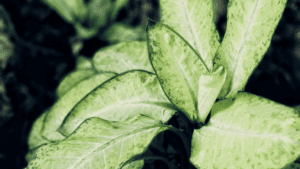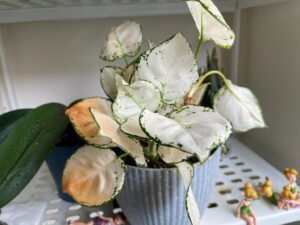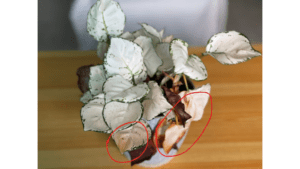Introduction
The plant Dumb cane (Dieffenbachia seguine) is a beautiful exotic plant and is commonly cherished as an indoor ornamental plant (1). This plant is well known for its beautiful colored splotched foliage that grows upright having a cane-like stem and lush green appearance. Dumb cane belongs to the angiosperm family, Aroideae subfamily. Other synonyms of Dumb cane are Dumb plant and Spotten dieffenbachia. The following article is about How to fix Dieffenbachia dumb cane simply by keeping this plant under indirect sunlight and misting regularly to maintain humidity.
Interesting Fact: Dumb cane gets its name from the temporary speechlessness that occurs after chewing the stem.
- The cells of the plants are armed with stinging crystals known as raphids that are composed of calcium oxalate.
- And this calcium oxalate is toxic to pet animals like dogs and cats.
- It causes stomach distress such as vomiting and diarrhea, blistering, and swelling of the mouth.
Appearance

Height
A dumb cane (Dieffenbachia seguine) is erect and can reach up to a height of 1-2 m.
Leaves
Leaves are 15-40 cm long and are simple (not divided into smaller leaflets) and alternate (only a single leaf is attached at each node) and are wide and long with parallel margins (oblong) and pointed apex.
Ornamentation of the leaf surface is formed by patterns of many irregular yellowing or cream-green splotches or white spots and flecks (1).
Flowers
Cylindrical spadix 14-17 cm long. Green or white spathe (15-25 cm). rarely flowers or need very favorable conditions to flower.
How to take care Dieffenbachia (Dumb cane plant)
Sunlight
Water
Potting mixture
The best season to repot this plant is the spring season every two years. The plant Dumb cane prefers well-draining soil and a heavy pot. If you want to grow the size of the plant then only add extra soil otherwise nourishing the existing soil will be enough for the plants. A slight pot may result in the toppling of the plant due to its heavy weight.
Fertilizer
Nourish the plant with a balanced fertilizer avoid during winters. For soil enrichment, I generally use organic fertilizer of 5 grams or 1 tablespoon which is rich in nitrogen once in 6 months.
Toxic to pets
The sap of the plant has oxalic acid crystals and hence keeps the plant away from cats and dogs. As Ingesting the leaves of the plant will cause vomiting, diarrhea, and stomach distress. In case of emergency place consul a Vet.
How to fix Dieffenbachia (Dumb cane plant)
Some of the common problems associated with Dieffenbachia (Dumb cane plant) are as follows. Let us explore How to fix Dieffenbachia dumb cane by following simple steps.
1. Fading of the leaf color

2. Browning of the leaf

You can see my plant is facing pale and brown leaf issues
-
- The primary reason for this is excessive direct sunlight or bright light.
- Too much bright light makes the leaves look bleached or washed out.
- In order to fix this trim away the brown and dry leaves and relocate the plant to a spot with low-light or indirect sunlight spot.
How to nourish the plant
Carefully loosen the soil surface and apply the fertilizer, ensuring it’s only on the top layer. Avoid direct contact between the fertilizer and the roots to prevent harm to the plant.
Other Tips
- Regularly wipe the leaves of this plant in order to keep them shiny and clean.
- Lower leaves naturally fade hence do not worry if only the lower leaves are drying off. Just cut them when they started turning yellow.
References
1. Your Houseplant’s First Year By D L Martin Pg: 104-105
2. The Little Book of House Plants and Other Greenery by: Emma Sibley Pg: 94-95
